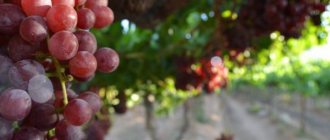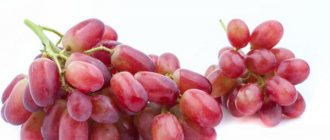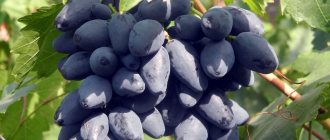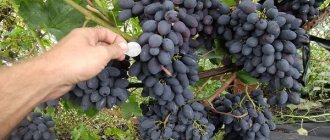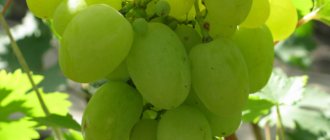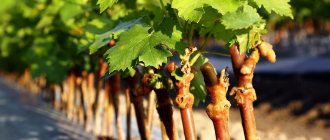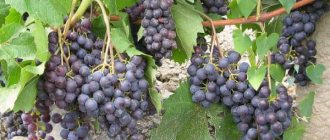Rules for planting grapes
Hadji Murat is a high-quality, very large-fruited hybrid form of grape of folk selection originally from Tajikistan. Based on its place of origin, it is often called “Tajikistan”, and in neighboring Uzbekistan the popular name Mercedes was firmly assigned to it, which also became its commercial name when exported from the country.
Very little is known about the birth of the hybrid. It is assumed that it originated from pollination of the local variety Tyagobi with Pobeda pollen, bred at the Central Asian VIR station in 1944. Often, Hadji Murat is mistakenly called Zabalkansky and Muscat of Hamburg as the parent pair, which does not correspond to reality.
As a result of the crossing, the new hybrid that emerged turned out to be quite unpretentious compared to traditional Central Asian varieties, but at the same time differed little from them in attractive appearance, refined taste and general attractiveness in the eyes of buyers. Thanks to this, it quickly spread throughout the region, and today it is produced in significant quantities for both local consumption and export.
In recent years, the exotic variety has become popular among domestic winegrowers, gradually expanding its geographical distribution in the European part of our country. Moreover, in contrast to the ancient varieties of grapes of the eastern ecological-geographical group, Hadji Murat during the introduction shows good plasticity and adaptability to atypical conditions, thanks to which he is gradually growing an army of sincere admirers here.
“In Memory of a Negro” is one of the most spectacular varieties in its appearance, which are often planted near gazebos to decorate the area.
Landing
Seedlings of the “Memory of Negrul” variety can be planted in open ground in spring and autumn. The best time is April - May and October, but everything will depend on the geographical latitude of the region and the prevailing weather conditions. The main thing is that young plants in the first days of their “life” in the ground are not exposed to low temperatures.
Place and soil
Grapes are picky about the soil in which they will grow. The best option is chernozem, loam, salt marshes and heavy soil with a high percentage of clay are unacceptable.
Another condition for successful cultivation of the variety is the absence of groundwater close to the surface.
“In Memory of a Negro” looks impressive as a living decoration of a personal plot: its lashes are often entwined with gazebos, special arches, and walls of buildings. It is important that the location of such a “decorative element” is on the south side of the objects, which will allow the sun to heat the heat-loving plant throughout the day.
The technology for planting seedlings of this grape is simple and no different from the classic scheme:
- Digging a hole 80 cm deep and 100 cm in diameter.
- Filling the bottom of the hole with drainage.
- Part of the soil removed from the pit is mixed with superphosphate and potassium chloride - it is subsequently poured on top of the drainage; the other part is with humus or compost. This soil will lie on top of mineral fertilizers, which can burn the tender roots of a young plant.
- Installing a seedling in the middle of the hole, straightening its root system.
- Covering it with soil, compacting the soil surface and watering it abundantly.
- Mulching the soil with sawdust, mown grass, hay, peat or humus.
Watering and fertilizing
The variety “Memory Negrule” is considered drought-resistant, but you should still not forget to water it. The irrigation scheme includes moistening:
- early spring and after shelter;
- when the eyes open;
- as the top layer of soil dries out.
It is important to remember that, despite the weather conditions, all watering must be stopped 30 days before the expected harvest date.
Watering is often combined with the application of liquid fertilizers. Mineral fertilizers are applied according to instructions and at certain times: in the spring - nitrogen-containing fertilizers for the development of foliage and shoots, during the formation of the ovary and in the summer - potassium and phosphorus, which have a direct impact on the quality of the taste of future fruits and their size.
In the fall, it will not be superfluous to fertilize with fresh manure, which will enrich the soil with beneficial bacteria.
Trimming
After the leaves fall, dry and diseased branches are removed, and damaged ones are removed in the spring. Also, during the spring “haircut,” it is advisable to shorten the vine to 7–8 eyes. The recommended load per bush is 45 eyes and 20 shoots. It would also be advisable to remove stepsons and immature shoots.
Diseases and pests
The Moldavian variety has strong immunity to most fungal diseases (mildew, oidium, gray rot, etc.). But you shouldn’t forget about prevention. Regular treatment with industrial fungicides can prevent the risk of developing any disease.
The variety also needs protection from birds that are not averse to eating juicy berries. There are a lot of tricks and scarecrows for them, but the birds quickly figure out that neither the scarecrow, nor the foil strips, nor the bells pose any danger to them. One of the rational solutions is a reinforced inflexible mesh fencing the grape bushes.
Wasps can be controlled by destroying their nests, as well as using sweet and sticky traps soaked in insecticides. The most humane way to deal with insects is to pack each bunch in a mesh bag: flying sweet tooths simply will not be able to get close to the berries and, therefore, harm the fruits.
Wintering
The variety has increased frost resistance - minus 25ºС. In a cold climate zone, where such temperatures are constant, it is still advisable to insulate the grape bushes.
The insulation scheme involves a standard set of measures: after trimming the bush, the lashes are removed from the supports, tied, bent to the ground and covered with it. Another option is to use agrofibre, hay, spruce branches or dry leaves.
Harvest storage
The “memory negrule” variety can retain all its taste characteristics and excellent presentation for 4 months, provided that the conditions for proper storage are met: temperature 0ºC - 5ºC, humidity - 90%.
Grapes “in memory of a Negro” are cultivated in the southern territories, as well as in the regions of the Middle Zone. Experienced winegrowers who grow the variety responsibly can enjoy its fruits even in the Ural Mountains and Siberia.
The Mercedes grape variety has gained popularity among winegrowers and winemakers, as its fruits are used for wine. In order to grow this variety at home, you need to know its main characteristics, as well as the advantages and disadvantages, planting rules and further care of this variety. You can learn about these and other details from the article.
To get a high-quality and rich harvest, you must follow the planting rules. First, you need to decide in which part of the plot it is better to plant seedlings, what the composition of the soil should be, how to properly prepare the vine before planting, what the holes should be like. You will learn more about this and more below.
It is best to plant bushes in mid-spring and after it, since at this time the soil has warmed up and during planting, the roots of the bushes will not be subject to frostbite. Planting is best done from late April to early May. Next, you can begin to select a site.
The following soil is suitable for planting:
- clayey - with such soil it is necessary to create good drainage;
- peat - this type of soil is best diluted with sand;
- sandstones - with such soil it is necessary to apply mineral fertilizers.
Then you can proceed with the following actions:
- dig a hole with a diameter of 80x80x80 cm;
- when digging a hole, it is necessary to divide the soil, the top layer in one direction (it is fertile), and the bottom in the other;
- then you need to make drainage, for this you need to fill the bottom of the hole 10 cm with crushed stone or replace it with expanded clay or pebbles;
- then the hole is sprinkled with the top layer of soil and watered abundantly;
- A peg is driven into the center of the hole. which will serve as a support for the bush;
- add fertilizer from humus, ash and sand to the soil in a ratio of 2:1:1 and add 200 g of superphosphate, fill the hole with this mixture until 40 cm remains to the edges, since the grape bush will be planted at this depth;
- water the soil generously;
- make a mound of soil around the support;
- trim the grape roots by 2-3 cm, as they may be dry;
- A grape bush is placed on the mound, the roots must be spread over the entire area, and the seedling must be tied to a support;
- then sprinkle the bush with the top layer of soil and compact it.
Caring for Mercedes grapes involves timely application of fertilizer, watering, as well as pruning dry and weak shoots and covering for the winter. You can find out about these and other details below.
Mercedes grapes require moisture. Watering is carried out in mid-May, during the period when frosts have passed and the soil has warmed up to 15°C. One bush consumes 4 liters of water, you can add 500 g of ash to it. Watering is carried out before and after the flowering period. It is necessary to water the grapes once a month. Water is poured directly under the vine. At the time of watering, it is necessary to loosen the soil so that water can better penetrate the soil and saturate it with oxygen.
Fertilizer application is necessary for the development and strengthening of the plant’s root system. The bushes must be fed before flowering and during the formation of the ovaries; for this it is necessary to dilute mullein with water in a ratio of 1:10.
You also need to spray the leaves with a solution of superphosphate; for this you need to dilute 100 g of the substance in 10 liters of water or use a preparation such as Ovary. After harvesting, it is necessary to apply potassium fertilizers.
Foliar fertilizers are also useful for Mercedes grapes. Before flowering, fertilizer is applied, the composition of which consists of boric acid 5 g, potassium sulfate 50 g, superphosphate 80 g, urea 40 g, all substances must be diluted in 10 liters of water.
Since this variety is not frost-resistant, it must be covered before the first frost. To do this, you first need to apply mineral fertilizers, treat the bushes against pests, and trim weak, dry and damaged vines after the leaves have fallen. The most common and simplest methods of covering grapes are using soil or film.
Description of the variety
Features of care
Caring for Mercedes grapes involves timely application of fertilizer, watering, as well as pruning dry and weak shoots and covering for the winter. You can find out about these and other details below.
Watering
Mercedes grapes require moisture. Watering is carried out in mid-May, during the period when frosts have passed and the soil has warmed up to +15°C. One bush consumes 4 liters of water, you can add 500 g of ash to it. Watering is carried out before and after the flowering period. It is necessary to water the grapes once a month. Water is poured directly under the vine. At the time of watering, it is necessary to loosen the soil so that water can better penetrate the soil and saturate it with oxygen.
Feeding
Fertilizer application is necessary for the development and strengthening of the plant’s root system. The bushes must be fed before flowering and during the formation of the ovaries; for this it is necessary to dilute mullein with water in a ratio of 1:10.
You also need to spray the leaves with a solution of superphosphate; for this you need to dilute 100 g of the substance in 10 liters of water or use a preparation such as Ovary. After harvesting, it is necessary to apply potassium fertilizers.
Foliar fertilizers are also useful for Mercedes grapes. Before flowering, fertilizer is applied, the composition of which consists of boric acid 5 g, potassium sulfate 50 g, superphosphate 80 g, urea 40 g, all substances must be diluted in 10 liters of water.
Preparing the plant for winter
Since this variety is not frost-resistant, it must be covered before the first frost. To do this, you first need to apply mineral fertilizers, treat the bushes against pests, and trim weak, dry and damaged vines after the leaves have fallen. The most common and simplest methods of covering grapes are using soil or film.
Covering with earth consists of the following steps:
- remove the vine from the support;
- dig a trench around the grapes;
- tie the branches into a bundle;
- lower the tied vine into the trench;
- cover it and the trunk with a 20-25 cm layer of soil.
Covering with film includes the following actions:
- after pruning, the branches are tied, as when covering with earth, this is necessary in order to conveniently cover the grapes;
- then you need to pin the vine to the soil;
- then the structure is covered with film and attached to the soil;
- the ends of the film are covered with earth.
The film structure should resemble a tunnel.
Agrobiological characteristics
Mercedes clusters grow to truly amazing sizes, up to 40 cm long and weighing up to 3 kg. The average weight of the brushes is in the range of 900-2000 grams; their shape is wide-conical, branched, and not too dense. The comb is very powerful, green, but sometimes woody at the base.
Due to the outstanding caliber of grapes, the variety is considered one of the largest-fruited. The slightly oval berry reaches a length of 40−50 mm, a diameter of 30−35 mm, and its weight can reach 20 grams or more. The color of the fruit is dark purple, close to black, the surface is covered with a dense layer of bluish waxy coating.
Thanks to the moderate looseness of the bunches, the grapes, despite their size, are not damaged by each other and are not subject to deformation. The pulp is dense, fleshy with a crunch when chewed, characteristic of oriental varieties. The taste is pleasant, harmonious without harsh, memorable tones in the aftertaste and aroma.
The sugar content of the juice is not bad. Even under domestic conditions, grapes accumulate up to 18-19 g/100 ml of sugars, and in Central Asia this figure is even higher. The titratable acidity at the time of harvesting maturity is about 5-6 g/l, and at full maturity it drops below. The skin of the berries is thin, but quite strong, does not separate from the pulp, and is faintly felt when eaten.
The harvest of this variety is mostly used fresh. In the Central Asian republics, Mercedes is in demand both on the local market and is exported abroad in significant volumes. The clusters and berries, outstanding in size and taste, leave no one indifferent, due to which the area under this highly commercial hybrid is constantly growing, but the volume of production does not keep up with demand.
Domestic farmers, especially in the south of the country, are also taking a close look at the variety, since the high price for an unusual, but at the same time very “marketable” variety promises high profitability of its cultivation. Amateur winegrowers who grow “sunny berries” for themselves are not far behind. For them, Mercedes is attractive for its oriental exoticism and at the same time its ability to grow in a temperate climate.
Hadji Murat belongs to the group of varieties with an average ripening period. Its growing season lasts 130-135 days, counting from the moment the buds open until the first clusters mature. The sum of active temperatures is also required to be moderate - 2700−2800°C. A similar level of heat supply is typical for the latitude of such cities as Saratov, Voronezh, Kursk and Chernigov, and this line, in principle, can be considered the northern border of Mercedes cultivation in open ground.
It should be taken into account that in these places, in the coolest seasons, without measures to increase the level of SAT, it may not ripen enough. Another limiting factor is the low frost resistance of the variety, at the level of −19…−21°C. This circumstance, however, does not prevent it from being cultivated, covering it for the winter wherever the grapes themselves have time to ripen.
Despite its eastern origin, which is often associated with low fruitfulness of shoots and the need for long pruning in connection with this, our Tajik hero is not at all distinguished by such shortcomings. Already the first eyes on the shoots of Mercedes turn out to be fruitful, and their productivity is so high that it requires restrictions during green operations. For this reason, the variety is prone to overload, although it is capable of “pulling” up to 30-35 kilograms of grapes with good agricultural technology and powerful shaping.
Leaving the crop on plants for a long time after ripening is practiced in the countries of Central Asia with their dry climate and soil water regime controlled by irrigation. However, in our country, Hadji Murat often demonstrates cracking of berries, which occurs due to a sharp change from dry periods to heavy rains.
Merlot grapes: characteristics and 6 care procedures for a super harvest
From an economic point of view, Mercedes, as already noted, shows itself to be much more unpretentious than traditional oriental varieties. But at the same time, for active development and rich, stable fruiting, without causing damage to the plants themselves, it requires the fulfillment of certain conditions of cultivation technology.
For placement, he prefers the warmest places on the slopes of southern exposures, or in wall culture - on the southern side of various buildings that protect the grapes from the cold northern winds. Any lowlands, cold slopes, and even open flat areas are strictly unsuitable for planting, if we are talking about regions where there is a risk of insufficient ripening of the crop.
The variety can be propagated by cuttings, due to their fairly easy rooting. However, this method is only possible where the soil is not infected with a dangerous grape pest - root phylloxera. If there is no guarantee that there will be no harmful root aphids on your site, then it is better to plant seedlings grafted onto phylloxera-resistant rootstocks.
Covering a Mercedes for the winter in domestic conditions is necessary almost everywhere. Only in the very south, where there is no likelihood of severe damage to the Tajik guest by frost, can one try to form standard, non-covering bushes, which, by the way, allow the hybrid to fully reveal its capabilities.
Spring pruning and subsequent operations to normalize the yield of the variety should be carried out according to patterns unusual for eastern varieties. For Hadji Murat, moderate and even severe shortening of the fruit shoots, leaving 4-8 eyes on them, is suitable. The total load on the bush is 30-35 buds with subsequent fragmentation of weak and fruitless shoots. Only one bunch is left on the fruitful Mercedes vines.
The fight against diseases must be carried out fully and carefully due to the low resistance of our hero to fungal pathogens. You can prevent cracking of berries, or at least reduce the scale of this phenomenon, by regular watering during dry periods, or by mulching the soil with materials intended for this purpose.
If these minimum requirements are met, Hadji Murat, in the southern style, will generously reward you with magnificent grapes of excellent taste.
Harvest storage
Care scheme for Merlot grapes
1. Land for planting
- the vineyard should be laid out on a flat, sunny place, protected from strong winds;
- The Merlot variety grows best in light, nutritious soils with neutral acidity. Crushed stone and sand in the planting nutrient mixture will give the soil additional breathability;
- According to experts, the taste of wines made from grapes grown on rocky soils is particularly subtle and refined;
- the next equally important requirement is that the groundwater level in the vineyard area must be at least 1.2 m from the soil surface. The Merlot variety, like any grape, does not grow well in waterlogged or waterlogged soil.
2.Feeding
The main fertilizer is applied to the soil during planting. For the next 3-4 years, the young bush does not need fertilizer.
After this period, the annual feeding scheme is approximately as follows:
- in spring, a couple of weeks before flowering: urea or ammonium nitrate, plus any nitrogen-containing mineral complex;
- at the time of filling the berries, while they are hard and green: fertilizing should be repeated with the previous composition, reducing the amount of nitrogen by half;
- in the fall, after harvesting, for digging, wood ash and ammonium sulfate.
Foliar feeding is carried out 3 times a year: 7-10 days before flowering, a couple of weeks after flowering and a month before harvest.
The spraying procedure should be carried out on a windless, cloudy, not hot day. Preparations for foliar feeding: Plantafol, Master, Novofert or similar composition
3. Watering
- The Merlot variety is a drought-resistant crop. There is no specific scheme for watering grapes, as such. The frequency is determined by weather conditions and soil composition, on average, 4-6 buckets per bush several times per season;
- It is worth noting that during the flowering of grapes, watering is not carried out, and 2-3 weeks before the berries are fully ripened, they stop completely;
- the last, moisture-charging watering, is carried out in the fall, after leaf fall
4.Pruning
For technical grape varieties, pruning is carried out in two stages:
- formative (in autumn): before the onset of frost, after leaf fall and slower sap flow. It is carried out on a mature vine in order to form new links involved in fruiting;
- sanitary in the spring: before the onset of sap flow and bud break, all dead or damaged branches during the winter are removed from the bush;
- after sanitary pruning, I secure the shoots to trellises
5.Detritus
- at the end of spring I remove secondary shoots, excess buds and foliage. As for foliage, the procedure is mandatory due to the fact that Merlot bushes are susceptible to mold when they thicken. Removing excess foliage improves air circulation inside the bush, thereby preventing the appearance of excessive dampness - the first cause of mold.
6.Prevention and treatment of diseases and pests
To prevent diseases, I carry out 2-3 treatments per season:
- first, in early spring - I spray the bush with Bordeaux mixture 3% or copper sulfate;
- before or after flowering - any fungicidal preparation;
- the last time - after autumn pruning, before covering for the winter - with copper sulfate or Bordeaux mixture.
Insect pests
The main thing you need to know is that healthy and well-groomed bushes are rarely attacked by pests. I consider the most effective measure in the fight against insects to be timely and regular care of the vineyard, including weeding, loosening, and removing excess foliage.
As a prevention or treatment, if pests are still noticed on the bushes, I recommend spraying with insecticides
Pros:
- excellent taste of wine;
- fairly rapid ripening;
- good indicators of climatic adaptive characteristics;
- It takes root easily and is practically pain free when transplanted;
- immune to mildew.
Minuses:
- has a tendency to peas;
- Without proper preventive measures, it can be affected by powdery mildew and is susceptible to oidium.
In the video - caring for Merlot grapes
I began to collect information on the care and proper pruning of vines. The result is a whole collection of recommendations and advice.
Grapes Beauty
Grapes Beauty variety description
- Beauty (lat. Vitis vinifera) was bred by crossing the Victoria variety and pollen of European-Amur grape forms. The variety got its name due to its unusual appearance.
- Early ripening grapes - ripen in 105-120 days from the beginning of the growing season. The grapes reach technical maturity in August.
- The yield from the bush is stable. The average weight of the brush is 500-800 g, the average weight of the berries is 6-8 g. The longer the brush remains on the bush, the softer the pulp and the worse the taste. The skin is dense, but thin; if there is excess moisture, it is prone to cracking of the berries.
- The flowers are bisexual, pollination rate is 100%.
- The root system is powerful, multi-tiered, branched, with deep heel roots;
- The crop is resistant to many diseases, but the hybrid form may lose this property, although it is capable of producing an earlier and more abundant harvest.
- Frost resistance down to -24, a distinctive feature is the resistance of young shoots to spring frosts;
The shades of pink inherent in this variety have long begun to attract gardening enthusiasts who want to grow it on their plantations.
This type of worthy representative of its genus, judging by the reviews, has a sufficient number of advantages over many of its fellows, which attract the close attention of gardeners.
A description of the Original grape variety will allow you to better understand its characteristics. Thus, this representative of the species is distinguished by its remarkable survival rate and ability to adapt to environmental conditions. Its seedlings grow quickly and do not require special care. The grapevine can withstand a significant drop in ambient temperature (over minus 20°C), but at the same time it is insulated in winter.
The Original overcomes diseases and fungal diseases that usually affect other grape varieties with noticeable resilience and courage. It is also distinguished by the abundance of its harvest.
The cultivated flower has characteristics of both sexes, which ensures productive pollination. In other words, the variety in question can grow fruitfully on its own, without needing the proximity of its fellows.
The appearance of the Original grape variety is quite attractive and unusual. Large berries, the weight of each of which, according to reviews, reaches from 5 to 7 grams, have an ovoid or nipple-shaped shape. Bunches of grapes, under favorable sunny and warm conditions, reach a weight of 500 to 700 grams.
Each of the berries is distinguished by its beauty and has white, pink or bluish skin, with a darker shade on the sunny side. Inside the fruit itself there is about 20% sugar, as well as a small amount of acidic elements, which is clearly felt when eating fresh berries. Reviews about the Original grapes and the wonderful taste of the preparations confirm that this variety can please lovers of natural compotes and wine drinks.
At the initial stage of growing Original grapes, you should seriously choose the place where you plan to plant. A necessary condition for the full development of fruits will be a sunny side, protected from strong wind gusts, but with normal ventilation of fresh air.
Feeding
Recipes
There are different recipes for making homemade wine. Let's look at the most famous:
Classic
The classic wine drink is made from:
- any sweet grape variety in the amount of 10 kg;
- sugar in the amount of 3 kg.
The prepared berries are crushed in a special container, which is subsequently covered with gauze and placed in a warm place to ferment for 5 days. The mixture should be mixed twice during the day. It is best to use a wooden spatula for this. The fruits that have had time to undergo fermentation are discarded in a colander, after which they are squeezed through cheesecloth to allow the juice to flow out. Next you need:
- pour the juice into bottles, sweeten it and mix;
- seal the container with a glove pierced in several places, then observe it for some time;
- if the gloves are not inflated, filter the wine and pour into clean bottles, which are sealed with corks;
- After a month, decant the drink again and put it in a cold place to infuse.
Berry and grape
Having studied many recipes for making homemade wine, you should pay attention to recipes with the addition of berries: for example, macaroni and currants. The essence of production is as follows:
- in the amount of one glass each, take currants and raspberries, which are ground with 2.5 kg of sugar;
- the container with the berry mass is removed to a warm place for 4 days;
- ripened grapes are sorted and then kneaded with a mortar;
- the berry starter is filled with the extracted grape juice, and the container is covered with a lid;
- the composition is infused for three days with periodic stirring;
- After 3 days, the floating berries are decanted.
And then the next stage of preparation begins:
- 1 kg of sugar dissolves in 10 liters of boiled water;
- this sugar composition along with grape juice is poured into a bottle, which is sealed with a glove and left for a week;
- at the beginning of the 8th day, sugar in the amount of 700 grams is added to the mixture, after which the berry wine is put away in a cool place for 2 months.
With added water
Many recipes call for the use of water when creating wine. However, this one is the best because it is the easiest to prepare at home. You will need:
- 7.5 liters of water;
- grapes in the amount of 5 kg;
- 3.5 kg of sugar.
The grapes are pressed, after which they are filled with water and sprinkled with sugar. The mixture is left for a week to ferment. To avoid the formation of mold, the wort is stirred several times a day. After a week, the liquid is separated from the sediment and poured into a bottle, which must then be covered with a glove. The container is placed in a cool place for a week, after which the drink is filtered. If you age the wine for a month, you can get enough of its richer taste.
Description and characteristics of the grape variety “in memory of a Negro”
| Selection | “Moldavian (Corna Negra)” and “Pierrell (Save Villar 20-366)” |
| Ripening period | Mid-late |
| Bunch weight | 300 – 700 g. |
| Berry weight | 9 years |
| Productivity | 45 – 50 kg per bush |
| Taste | Harmonious |
| Bush | Vigorous |
| Frost resistance | Up to -25°C. |
| Disease resistance | High |
One of the best options for beginning winegrowers is the “Memory Negrule” variety: it is unpretentious in care, and at the same time has a lot of other advantages. A worthy reward for the diligence and diligence of a beginner in the grape business will be a bountiful harvest of sweet and juicy fruits.
Advantages and disadvantages
Before planting grapes, it is necessary to find out all the advantages and disadvantages of the selected variety.
Pros:
- High yield.
- High rates of transportability and storage.
- Versatility of use.
- Frost resistance down to -25ºС.
- High immunity to mildew, oidium, gray rot, phylloxera, and grape mite.
Minuses:
- The need for crop rationing.
Origin
In 1975, in the Moldavian SSR, a group of NIIViV employees (M. S. Zhuravel, G. M. Borzikova, I. P. Gavrilov, I. N. Naidenova and G. A. Savin) developed a new grape variety “in memory of the Negrul.” It was obtained by crossing the Moldavian variety (Corna Negra) with the interspecific hybrid Pierrell (Save Villar 20-366).
Sweet and sour grapes “in memory of a Negrule” are quite unpretentious in cultivation and differ from other hybrid forms in their high yield. It is worth noting other good varieties, such as “early gourmet”, “kodryanka” and “lora”.
Ripening period
The hybrid form of grapes “in memory of a negroul” is considered to be medium-late in terms of berry ripening: from the moment the sap flows in the plant and the formation of buds begins, about 145–155 days pass before the harvest begins. Typically, the clusters are fully ripened by mid-September, although winegrowers living in southern latitudes note earlier ripening of the clusters.
The “memory of a negro” grape is a powerful and tall bush, reaching a height of 3 meters, while the number of fruiting shoots is ¾ of the total. The preferred formation is a double-armed cordon with a trunk height of up to 80 cm, provided there is no need for shelter for the winter. In regions with a temperate or harsh climate, it is better to choose a design with obliquely directed sleeves without a standard.
The leaves are light green, five-lobed, with slight pubescence on the underside of the leaf blade.
The bush of the variety has male and female flowers, so flowering and ovary formation are always abundant and stable.
Bunches and berries
The brushes of this variety are cylindrical in shape, in most cases they have “wings”. The average size of the bunches is 20 by 12 cm, and the weight is 300–700 g, but especially large specimens can weigh up to a kilogram.
The dark purple, almost black berries of the “Memory Negrule” variety appear blue from afar due to the thick coating of pruin on them.
Their shape is ovoid, the tips slightly pointed towards the bottom. The average size is 3 by 2 cm, weight is 9 g. The crispy skin does not cause discomfort when eating the fruit. The pulp is juicy, fleshy, sweet (16 – 18 g of sugar per 100 g) with a light and pleasant sourness (6 – 8 g/l). Each berry contains 2–3 seeds.
The variety has a pleasant, harmonious sweet and sour taste without any special frills. However, the taste qualities of the “negrul memory” are highly rated by professionals - 8.5 points out of 10.
Productivity
If you comply with the requirements of varietal agricultural technology, you can get a decent harvest from one bush - 45 - 50 kg of fruits of excellent quality. On an industrial scale, average yields are also impressive: 180 - 200 centners per hectare.
The “Memory Negrule” variety is one of the best varieties of black table grapes with a medium-late ripening period, as evidenced by the table below with the comparative characteristics of the varieties of this group.
| Sign | Variety | |||
| In memory of Negrul | Strashensky | Ataman | Autumn black | |
| Ripening period | 145 – 155 days | 130 – 145 days | 130 – 145 days | 140 – 150 days |
| Frost resistance | -25C | -17C | -24С | -22C |
| Productivity | 45 – 50 kg | Up to 30 kg | Up to 20 kg | Up to 20 kg |
| Bunches | 300 g – 1 kg | 1 – 1.5 kg | 900 g – 2 kg | 500 – 700 g |
| Taste | Sweet and sour, simple | Harmonious with light fruity notes | Harmonious and refreshing | Simple, harmonious |
| Color | Dark purple | Dark purple | Dark purple | Black |
| Disease resistance | Above average | Average | Above average | Above average |
| Shelf life | Up to 4 months | Up to 1 month | Up to 4 months | Up to 4 months |
| Sugar accumulation | 16 – 8% | 18 – 19% | 16 – 20 % | 16 – 18% |
| Acidity | 6 – 8g/l | 7 – 8 g/l | 6 – 8 g/l | 7 – 8 g/l |
The best varieties
To prepare homemade wine, you need to select suitable grape varieties. The most famous are:
Light
The best taste is characteristic of light grape varieties growing in the East. These include:
a) “Kishmish White” or “Sultanina”
This variety has relatively small berries and clusters, but the level of sugar content reaches 30% with a fairly low degree of acidity, equating to only 6 grams per liter. A small disadvantage of “Sultanina” is its late ripening, which requires a very hot climate. Cultivation of the variety is also done in the northern regions, but only in greenhouse conditions.
b) "Timur"
It has an average degree of sugar content, within 22%, with an acidity of 6 grams per liter. A characteristic feature of the variety is its early ripening: the berries ripen within 115 days. High resistance to frost makes it possible to grow “Timur” in the north. At the same time, covering the vine still remains mandatory.
c) "Flora"
The variety also fully ripens within 115 days, demonstrating high yield. The berries are quite large and weighty, and may have several large seeds inside. The degree of sugar content also exceeds 20, but the acidity level is even lower than in the two previous varieties: only 5 grams per liter.
Dark
No less sweet are dark grape varieties, which can compete with light grape varieties. The best of them are presented:
a) “Kishmish Black”
The most productive variety with a high sugar content of 27% and a low acidity level of 4 grams per liter. At the same time, fruits of different sizes grow, which are generally medium-sized. Full ripening occurs within 130 days.
b) “Muscat of Hamburg”
The fruits of the mentioned grape variety have a dark blue color, as well as a strongly pronounced taste and aroma of muscat. The harvest ripens within 150 days. Refers to grape varieties with an extremely low degree of frost resistance. When the temperature drops to 18 degrees, half of the future harvest dies. Sugar and acidity levels are similar to those of the Timura variety.
c) “Ichkimar”
The grape variety comes from Uzbekistan. Refers to mid-early varieties, ripening within 135 days. It is predominantly grown in arid climates, but is a moisture lover.
Advantages and disadvantages
Like any early crop, the Mercedes grape variety has advantages and disadvantages.
- Advantages:
- mid-season variety;
- high ripening of shoots;
- keeping quality - 90%;
- large bunches;
- a bountiful harvest.
- Flaws:
- average disease resistance;
- low frost resistance down to -22°C, and it is necessary to cover the vine for the winter;
- bunches of grapes are prone to overloading.
Diseases and pests
Mercedes grapes are susceptible to diseases such as downy mildew and oidium.
For prevention purposes it is necessary:
- carefully inspect the vine for pests;
- treat the bushes every 8-10 days, alternating the preparations “Thanos” and “Strobe”;
- prune old and weak vines;
- treat the plant with preparations that contain copper, this can be “Profit Gold” or “Ordan”.
As mentioned earlier, the “Marcelo” variety has sufficient resistance to oidium and mildew, as well as gray mold, which are most common in vineyards. However, for preventive purposes, it is recommended to spray plants in spring with copper-containing preparations, as well as fungicides, which will protect the plant as effectively as possible.
Spraying should be carried out in the spring, at the stage of increasing the temperature to approximately 11-12 degrees Celsius.
Good results are achieved by using Nitrafen. The first spraying should be done before buds open. The second treatment is performed two weeks after the first spraying.
Features of care
Caring for the Marcelo grapevine does not differ significantly from the cultivation of other grape varieties.
Watering
Watering should be carried out as the soil dries out. The standard volume of water for each grape bush is about one medium-sized bucket. During the dry spring period, as well as after the autumn harvest, moisture-recharging irrigation is carried out, which allows the plant to quickly adapt to changing weather conditions.
Top dressing
As a rule, gardeners use foliar feeding of grapevines. Fertilizers should be applied according to the following scheme:
- in the spring, 20 g of superphosphate, 10 g of ammonium nitrate and 5 g of potassium salt are used per ten liters of water. This amount is used to feed one plant;
- ten days before flowering, the grapevine is fed with a solution similar in composition and quantity;
- a week before ripening, fertilizers in the form of superphosphate and potassium substances should be applied to the grape bushes, without the use of nitrogen;
- After harvesting, it is recommended to use potassium fertilizers for feeding, which have a beneficial effect on increasing the winter hardiness of grapes.
For any manifestations of malnutrition, complex preparations that are used for foliar feeding should be used.
Trimming
Marcelo grapes require long pruning with ten or twelve buds. The optimal number of eyes for each grape bush of this variety depends on the quality of the shoot and can vary from thirty to thirty-five.
Pruning should be carried out with a clean and sharp tool to reduce the traumatic factor and speed up the adaptation of the plant.

